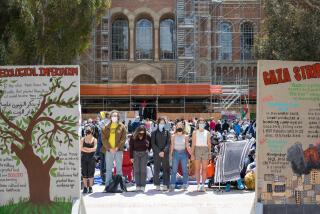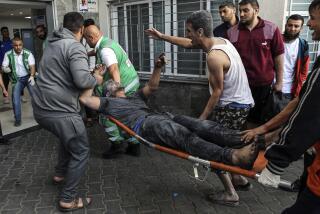Vietnam’s 1968 Tet Offensive Offers Parallels for Today
- Share via
We have heard a lot lately about similarities between the attacks of Sept. 11 and the Japanese bombing of Pearl Harbor. But we needn’t go so far back in our history to find an even more direct parallel.
North Vietnam’s Tet Offensive of 1968 involved terrorism on a grand scale. And while it was not on American soil, it was a calamity for the United States. In the end, though, Tet exposed errors in our foreign policy that led to positive change. We can hope such a benefit emerges from our recent trauma.
The similarities between Tet and the terrorist attacks are not exact, but they are significant. On Nov. 16, 1967, Gen. William Westmoreland assured the U.S. Congress, “We have got our opponents almost on the ropes.”
Six weeks later, the Viet Cong in South Vietnam shocked the world by launching the Tet Offensive, which involved simultaneous uprisings by communists living undercover in 39 of the 44 provincial capitals of South Vietnam. Preliminary planning for the assault had begun four years earlier, in 1964. Members of the Politburo in Hanoi had been divided over the tactic, however. As they debated, Viet Cong in the South, led by a political officer named Tran Bach Dang, secretly started to smuggle arms and ammunition into Saigon.
At one point, Dang estimated that his forces had stockpiled weaponry at 400 houses throughout the city. During the many months of planning, Dang lived openly among his enemies in a house in a fashionable sector of Saigon. His next-door neighbor was U. S. Deputy Ambassador William Porter.
A committed communist intellectual, Dang had a personal motive in plotting a major offensive: For most of 1967, his wife, Nguyen Thi Chon, another National Liberation Front official, had been imprisoned and tortured by the Saigon police, with the connivance of the CIA.
Tet, then, was the culmination of long and meticulous preparation while its architects went about their day-to-day activities in full view of those they hoped to destroy. And they were motivated by both ideology and a visceral hatred.
From the day that Tet exploded across the South Vietnamese landscape, participants and observers have debated its effectiveness. Critics sometimes claim that it was a failure, and they have a point. Optimistic Politburo members expected their offensive to set off a general uprising among the people. The South Vietnamese population--happy to be freed from the yoke of the American puppet masters, Nguyen Van Thieu and Nguyen Cao Ky--would rush into the streets to welcome their communist liberators.
It didn’t happen that way. War-weary and terrified, the 4 million residents of Saigon huddled behind their doors and refused the repeated communist demands that they come out.
Militarily, too, the results of the offensive were mixed. Certainly, the well-coordinated assaults provided a striking example of stealth and coordination. At the very least, they exploded Westmoreland’s fatuous optimism.
American and South Vietnamese forces did manage to retake those capitals. But in the process, cities were left in ruins and civilian casualties ran high. Americans winced when Peter Arnett of the Associated Press quoted a U.S. major as they stood amid the wreckage of Ben Tre, a city leveled by the American response to the Tet Offensive: “It became necessary,” the major said, “to destroy the town to save it.”
That quote still hung in the air when President Lyndon B. Johnson pronounced the communists’ assault a complete failure. George Aiken, Republican senator from Vermont, expressed the average American’s reaction: “If this is a failure, I hope the Viet Cong never have a major success.”
But, in fact, the North Vietnamese had scored just such a success. The communists had always fought a political war to complement military action on the ground, and their units included political cadres to remind their troops why they were fighting.
Hanoi also knew that the North had support around the world from onlookers appalled by a great power attempting to pulverize an impoverished land of peasant farmers. Tet made those critics of American policy even more vocal about ending the stalemate.
Even President Johnson’s “wise men,” the former government officials he occasionally called to Washington for consultation, were affected by Tet. In November 1967, they had urged him to hold steady in Vietnam. After Tet, on March 25, 1968, the same men were telling him that “we can no longer do the job we set out to do .... “
Six days later, Johnson took himself out of the 1968 presidential race and opened the way for negotiations with Hanoi.
At that point, the parallels with Vietnam end. As the delegates met in Paris, the goals of each team were clear-cut. The North Vietnamese wanted the withdrawal of U.S. troops from the South. Washington wanted the same, but under terms that would not be seen as a humiliating defeat. The terrorist goals on Sept. 11 seem to have been apocalyptic and not subject to negotiation. Our humiliation is their priority.
And yet, just as the Tet offensive produced a crucial reexamination of U.S. policy, so might this month’s ghastly events set the country on a better path. We have learned in the worst possible way that America cannot go it alone.
For the past five years, we ignored the report on terrorism submitted by former CIA chief R. James Woolsey and Harvard’s Joseph S. Nye, as well as subsequent warnings. We scoffed lately at regional pacts and were preparing to abrogate long-standing treaties. Secretary of State’s Colin L. Powell’s influence in the Bush White House appeared on the decline. We were telling the world that we needed no allies.
Now we need them desperately. As secretary of State, Powell has both the stature and seemingly the will to fight against a complete reliance on military measures. And there are other hopeful signs: The House of Representatives finally voted last Monday to release $582 million of the arrears the United States has long owed to the United Nations. In Brussels, Paul D. Wolfowitz, the deputy Defense secretary, is finding out that our NATO allies will not be issuing a blank check of support. In the long run, their skepticism could help to guarantee a more careful response.
Perhaps we are prepared to apply again to foreign policy the lessons of preventative medicine and to see our foreign aid in a new light.
We pride ourselves as being a generous people, and rightly so. But our aid has also reflected our national self-interest. Even the Marshall Plan drew bipartisan backing largely because rebuilding Europe offered us protection against the Soviet Union. Throughout the Cold War, foreign aid was sold to Congress as one means of containing an expansionist enemy.
For a decade, that communist threat has been gone. On Sept. 11, it was replaced by a threat at least as menacing.
We have always known the prescription for a troubled world beset with hunger, ignorance and disease. Now we can act on it. If we put some of the billions suddenly available to combat terrorism into measures of prevention, we may look back on Sept. 11 as the day the Americans who died left behind a better, safer world as their legacy.
More to Read
Sign up for Essential California
The most important California stories and recommendations in your inbox every morning.
You may occasionally receive promotional content from the Los Angeles Times.










